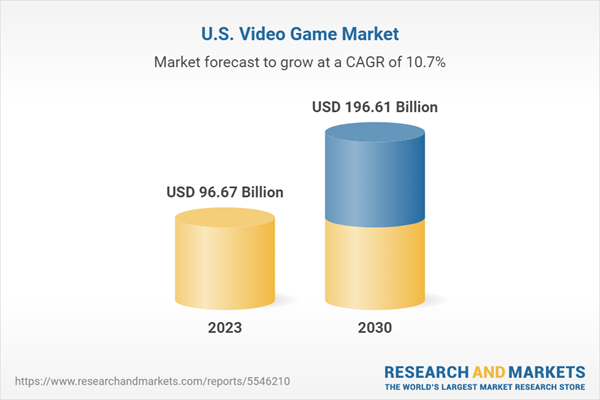The US gaming industry is undergoing a speedy increase and diversification. According to an ESA observation, over 227 million players inside the United States area played video games last year. Overall, 80% of the gamers are over 18 years old. Furthermore, 76% of American youngsters under 18 years are players. In addition, 74% of American households have at least one online game player. Also, 71% of parents agree that video games have been a far-wanted break for their youngsters throughout the pandemic. Also, 66% of parents agree that video games made the transition to distance learning extra reachable.
United States video game market will grow at a CAGR of 10.67% from 2024 to 2030
The video gaming market shared within the United States has followed new strategies to address customer growing demand and make their involvement more consumer-friendly. One such strategy via the video gaming industry is migrating from console gaming to cell (mobile) gaming, making video games handy throughout a broad spectrum of digital platforms. Companies within the United States video gaming enterprise constantly enhance their platforms to provide top-notch amusing for customers. Gaming apps now provide free trial video games to attract new purchasers.Over the last decade, the size of video game market in the USA has experienced tremendous modifications, with video game players undertaking numerous games throughout different gaming apps. The creation of the metaverse is poised to transform the gaming industry via developing a shared virtual space wherein customers have interaction via virtual avatars. While broader adoption of the metaverse is predicted, video gaming currently leads in exploring this exciting new frontier.
Cloud gaming is gaining recognition in the US, permitting the play of sophisticated video games on portable gadgets like smartphones getting rid of the need for hardware enhancements. The achievement of cloud gaming is carefully linked to the deployment of 5G speed and limitless plans, attracting gamers who decide upon mobile play. The improvement and funding in 5G infrastructure are critical for its enlargement.
Moreover, mobile video games outperform their PC opposite numbers, driven through the supply of free toplay options. The United States video gaming market has shifted extensively because of the significant use of video enabled smartphones, a developing wide variety of female gamers, and multiplied access to cloudbased services. While trends like digital content and subscription primarily based trends are gaining traction, there stays a substantial market for physical video games and hardware upgrades.
The upward thrust of technologies like virtual reality (VR) offers interesting opportunities for the gaming industry. To stay efficaciously serve their audiences, gaming businesses need to morden day abreast of cutting-edge trends, leveraging them to innovate content, shipping techniques, and advertising approaches. This involves as the ability of latest technologies and being attuned to various customers need and choices. As a result, the USA video game market reached US$ 96.67 Billion in 2023.
Mobile video games are anticipated to dominate the United States Video Game market
The United States Video Game Market is segmented into categories: Cloud Gaming, Download Games, Games Live Streaming, Gaming Networks, Gaming Advertising, Mobile Games, and Online Games. The mobile gaming market proportion in the United States has been increasing and is expected to maintain its upward fashion into 2024. With the steady technological improvements and converting customer choices, the mobile gaming landscape is evolving at a remarkable pace.Developers at the moment are exploring new dimensions of gameplay with the advent of AR glasses and advanced AR technology on smartphones. The United States video gaming marketplace is growing, and smartphones play a vital role. Social media systems like Instagram and Facebook have joined the trend by developing unique mobile video games to stand out and leverage attractive games to enhance their advertising and marketing strategies. Ericsson additionally reviews that the 5G generation has enabled quicker speeds (20 instances faster than 4G) and reduced latency (from 20 ms to five ms), main to a boom in notable AAA mobile games in the market.
- Years age group will grow at the fastest CAGR during the forecast period
Male gamers occupy the majority of the market share in the United States video game industry
By Gender, the United States Video Game Market is classified into Female and Male. The United States video game market is predominantly ruled by male users, who preserve more than half of the market proportion. This demographic trend underscores male players' extensive influence and engagement in gaming. The industry caters to various gaming options, but the prevalence of male players suggests a target focus on this demographic. Understanding and responding to male gamers' choices, interests, and behaviors remain essential for video game market stakeholders, shaping the industry's content, advertising strategies, and standard market dynamics.Medium Income level will spend more revenue in the United States video game industry
By income, the United States Video Game Market is split into High Income, Medium Income, and Low Income. In the US Video Game Industry, consumers with a medium income level have emerged as contributors, allocating a massive portion of their income to gaming-related expenditures. This demographic's propensity to spend on video games, consoles, subscriptions, and in-game purchases underscores the industry's attraction across various income brackets. The medium-income segment actively engages in gaming, forming an extensive market share and influencing the industry's economic panorama. Understanding and catering to this income group's alternatives and buying patterns are pivotal for stakeholders searching to optimize sales and beautify market penetration inside the dynamic video game sector in the United States.Key Players
Activision Blizzard Inc., Electronic Arts, Microsoft, Nintendo Co. Ltd, Take-Two Interactive Software, Sony, Apple, and Bandai Namco Holdings Inc. are prominent players in the United States Video Game Industry.This research report provides an all-encompassing analysis of the key growth drivers and restraining factors, demand, and their projections for the upcoming years.
By Category - United States Video Game Market
- Cloud Gaming
- Download Games
- Games Live Streaming
- Gaming Networks
- In -game Advertising
- Mobile Games
- Online games
By Age Group - United States Video Game Market
- 18-24
- 25-34
- 35-44
- 45-54
- 55-64
By Gender - United States Video Game Market
- Male
- Female
By Income - United States Video Game Market
- Low Income
- Medium Income
- High Income
Company has been covered from 3 Viewpoints:
- Overview
- Recent Development
- Revenue
Company Profile
- Activision Blizzard Inc
- Electronic Arts
- Microsoft
- Nintendo Co. Ltd
- Take-Two interactive Software
- Sony
- Apple
- Bandai Namco Holdings Inc
Table of Contents
Companies Mentioned
- Activision Blizzard Inc
- Electronic Arts
- Microsoft
- Nintendo Co. Ltd
- Take- Two interactive Software
- Sony
- Apple
- Bandai Namco Holdings Inc
Methodology
In this report, for analyzing the future trends for the studied market during the forecast period, the publisher has incorporated rigorous statistical and econometric methods, further scrutinized by secondary, primary sources and by in-house experts, supported through their extensive data intelligence repository. The market is studied holistically from both demand and supply-side perspectives. This is carried out to analyze both end-user and producer behavior patterns, in the review period, which affects price, demand and consumption trends. As the study demands to analyze the long-term nature of the market, the identification of factors influencing the market is based on the fundamentality of the study market.
Through secondary and primary researches, which largely include interviews with industry participants, reliable statistics, and regional intelligence, are identified and are transformed to quantitative data through data extraction, and further applied for inferential purposes. The publisher's in-house industry experts play an instrumental role in designing analytic tools and models, tailored to the requirements of a particular industry segment. These analytical tools and models sanitize the data & statistics and enhance the accuracy of their recommendations and advice.
Primary Research
The primary purpose of this phase is to extract qualitative information regarding the market from the key industry leaders. The primary research efforts include reaching out to participants through mail, tele-conversations, referrals, professional networks, and face-to-face interactions. The publisher also established professional corporate relations with various companies that allow us greater flexibility for reaching out to industry participants and commentators for interviews and discussions, fulfilling the following functions:
- Validates and improves the data quality and strengthens research proceeds
- Further develop the analyst team’s market understanding and expertise
- Supplies authentic information about market size, share, growth, and forecast
The researcher's primary research interview and discussion panels are typically composed of the most experienced industry members. These participants include, however, are not limited to:
- Chief executives and VPs of leading corporations specific to the industry
- Product and sales managers or country heads; channel partners and top level distributors; banking, investment, and valuation experts
- Key opinion leaders (KOLs)
Secondary Research
The publisher refers to a broad array of industry sources for their secondary research, which typically includes, however, is not limited to:
- Company SEC filings, annual reports, company websites, broker & financial reports, and investor presentations for competitive scenario and shape of the industry
- Patent and regulatory databases for understanding of technical & legal developments
- Scientific and technical writings for product information and related preemptions
- Regional government and statistical databases for macro analysis
- Authentic new articles, webcasts, and other related releases for market evaluation
- Internal and external proprietary databases, key market indicators, and relevant press releases for market estimates and forecasts

LOADING...
Table Information
| Report Attribute | Details |
|---|---|
| No. of Pages | 150 |
| Published | January 2024 |
| Forecast Period | 2023 - 2030 |
| Estimated Market Value ( USD | $ 96.67 Billion |
| Forecasted Market Value ( USD | $ 196.61 Billion |
| Compound Annual Growth Rate | 10.6% |
| Regions Covered | United States |
| No. of Companies Mentioned | 8 |








![Video Game Market: Trends, Opportunities and Competitive Analysis [2024-2030] - Product Image](http://www.researchandmarkets.com/product_images/12316/12316439_60px_jpg/video_game_market.jpg)
